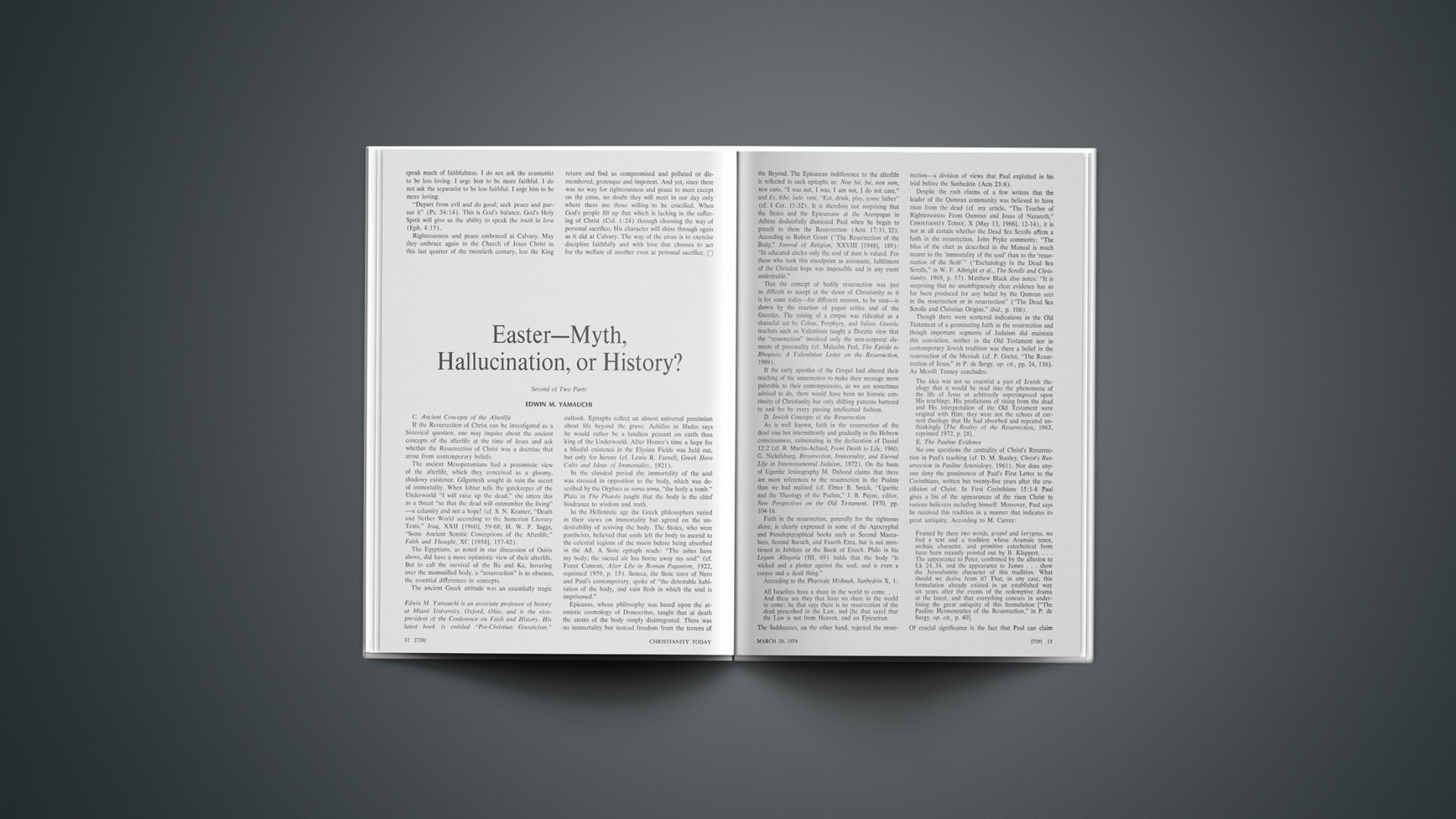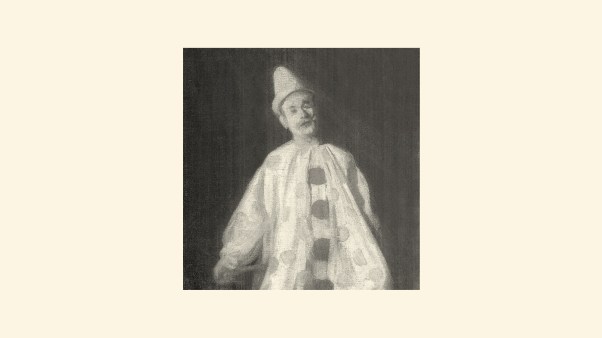Second of Two Parts
C. Ancient Concepts of the Afterlife
If the Resurrection of Christ can be investigated as a historical question, one may inquire about the ancient concepts of the afterlife at the time of Jesus and ask whether the Resurrection of Christ was a doctrine that arose from contemporary beliefs.
The ancient Mesopotamians had a pessimistic view of the afterlife, which they conceived as a gloomy, shadowy existence. Gilgamesh sought in vain the secret of immortality. When Ishtar tells the gatekeeper of the Underworld “I will raise up the dead,” she utters this as a threat “so that the dead will outnumber the living”—a calamity and not a hope! (cf. S. N. Kramer, “Death and Nether World according to the Sumerian Literary Texts,” Iraq, XXII [19601], 59–68; H. W. F. Saggs, “Some Ancient Semitic Conceptions of the Afterlife,” Faith and Thought, XC [19581, 157–82).
The Egyptians, as noted in our discussion of Osiris above, did have a more optimistic view of their afterlife. But to call the survival of the Ba and Ka, hovering over the mummified body, a “resurrection” is to obscure, the essential differences in concepts.
The ancient Greek attitude was an essentially tragic outlook. Epitaphs reflect an almost universal pessimism about life beyond the grave. Achilles in Hades says he would rather be a landless peasant on earth than king of the Underworld. After Homer’s time a hope for a blissful existence in the Elysian Fields was held out, but only for heroes (cf. Lewis R. Farnell, Greek Hero Cults and Ideas of Immortality, 1921).
In the classical period the immortality of the soul was stressed in opposition to the body, which was described by the Orphics as soma sema, “the body a tomb.” Plato in The Phaedo taught that the body is the chief hindrance to wisdom and truth.
In the Hellenistic age the Greek philosophers varied in their views on immortality but agreed on the undesirability of reviving the body. The Stoics, who were pantheists, believed that souls left the body to ascend to the celestial regions of the moon before being absorbed in the All. A Stoic epitaph reads: “The ashes have my body; the sacred air has borne away my soul” (cf. Franz Cumont, After Life in Roman Paganism, 1922, reprinted 1959, p. 15). Seneca, the Stoic tutor of Nero and Paul’s contemporary, spoke of “the detestable habitation of the body, and vain flesh in which the soul is imprisoned.”
Epicurus, whose philosophy was based upon the atomistic cosmology of Democritus, taught that at death the atoms of the body simply disintegrated. There was no immortality but instead freedom from the terrors of the Beyond. The Epicurean indifference to the afterlife is reflected in such epitaphs as: Non fui, fui, non sum, non curo, “I was not, I was, I am not, I do not care,” and Es, bibe, lude, veni, “Eat, drink, play, come hither” (cf. 1 Cor. 15:32). It is therefore not surprising that the Stoics and the Epicureans at the Areopagus in Athens disdainfully dismissed Paul when he began to preach to them the Resurrection (Acts 17:31, 32). According to Robert Grant (“The Resurrection of the Body,” Journal of Religion, XXVIII [1948], 189): “In educated circles only the soul of man is valued. For those who took this standpoint as axiomatic, fulfillment of the Christian hope was impossible and in any event undesirable.”
That the concept of bodily resurrection was just as difficult to accept at the dawn of Christianity as it is for some today—for different reasons, to be sure—is shown by the reaction of pagan critics and of the Gnostics. The raising of a corpse was ridiculed as a shameful act by Celsus, Porphyry, and Julian. Gnostic teachers such as Valentinus taught a Docetic view that the “resurrection” involved only the non-corporal elements of personality (cf. Malcolm Peel, The Epistle to Rheginos: A Valentinian Letter on the Resurrection, 1969).
If the early apostles of the Gospel had altered their teaching of the resurrection to make their message more palatable to their contemporaries, as we are sometimes advised to do, there would have been no historic continuity of Christianity but only shifting patterns battered to and fro by every passing intellectual fashion.
D. Jewish Concepts of the Resurrection
As is well known, faith in the resurrection of the dead rose but intermittently and gradually in the Hebrew consciousness, culminating in the declaration of Daniel 12:2 (cf. R. Martin-Achard, From Death to Life, 1960; G. Nickelsburg, Resurrection, Immortality, and Eternal Life in Intertestamental Judaism, 1972). On the basis of Ugaritic lexicography M. Dahood claims that there are more references to the resurrection in the Psalms than we had realized (cf. Elmer B. Smick, “Ugaritic and the Theology of the Psalms,” J. B. Payne, editor, New Perspectives on the Old Testament, 1970, pp. 104–16.
Faith in the resurrection, generally for the righteous alone, is clearly expressed in some of the Apocryphal and Pseudepigraphical books such as Second Maccabees, Second Baruch, and Fourth Ezra, but is not mentioned in Jubilees or the Book of Enoch. Philo in his Legum Allegoria (III, 69) holds that the body “is wicked and a plotter against the soul, and is even a corpse and a dead thing.”
According to the Pharisaic Mishnah, Sanhedrin X, 1:
All Israelites have a share in the world to come.… And these are they that have no share in the world to come: he that says there is no resurrection of the dead prescribed in the Law, and [he that says] that the Law is not from Heaven, and an Epicurean.
The Sadduccees, on the other hand, rejected the resurrection—a division of views that Paul exploited in his trial before the Sanhedrin (Acts 23:6).
Despite the rash claims of a few writers that the leader of the Qumran community was believed to have risen from the dead (cf. my article, “The Teacher of Righteousness From Qumran and Jesus of Nazareth,” CHRISTIANITY TODAY, X [May 13, 1966], 12–14), it is not at all certain whether the Dead Sea Scrolls affirm a faith in the resurrection. John Pryke comments: “The bliss of the elect as described in the Manual is much nearer to the ‘immortality of the soul’ than to the ‘resurrection of the flesh’ ” (“Eschatology in the Dead Sea Scrolls,” in W. F. Albright et al., The Scrolls and Christianity, 1969, p. 57). Matthew Black also notes: “It is surprising that no unambiguously clear evidence has so far been produced for any belief by the Qumran sect in the resurrection or in resurrection” (“The Dead Sea Scrolls and Christian Origins,” ibid., p. 106).
Though there were scattered indications in the Old Testament of a germinating faith in the resurrection and though important segments of Judaism did maintain this conviction, neither in the Old Testament nor in contemporary Jewish tradition was there a belief in the resurrection of the Messiah (cf. P. Grelot, “The Resurrection of Jesus,” in P. de Surgy, op. cit., pp. 24, 136). As Merrill Tenney concludes:
The idea was not so essential a part of Jewish theology that it would be read into the phenomena of the life of Jesus or arbitrarily superimposed upon His teachings. His predictions of rising from the dead and His interpretation of the Old Testament were original with Him; they were not the echoes of current theology that He had absorbed and repeated unthinkingly [The Reality of the Resurrection, 1963, reprinted 1972, p. 28].
E. The Pauline Evidence
No one questions the centrality of Christ’s Resurrection in Paul’s teaching (cf. D. M. Stanley, Christ’s Resurrection in Pauline Soteriology, 1961). Nor does anyone deny the genuineness of Paul’s First Letter to the Corinthians, written but twenty-five years after the crucifixion of Christ. In First Corinthians 15:1–8 Paul gives a list of the appearances of the risen Christ to various believers including himself. Moreover, Paul says he received this tradition in a manner that indicates its great antiquity. According to M. Carrez:
Framed by these two words, gospel and kerygma, we find a text and a tradition whose Aramaic tenor, archaic character, and primitive catechetical form have been recently pointed out by B. Klappert.… The appearance to Peter, confirmed by the allusion to Lk 24:34, and the appearance to James … show the Jerusalamite character of this tradition. What should we derive from it? That, in any case, this formulation already existed in an established way six years after the events of the redemptive drama at the latest, and that everything concurs in underlining the great antiquity of this formulation [“The Pauline Hermeneutics of the Resurrection,” in P. de Surgy, op. cit., p. 40].
Of crucial significance is the fact that Paul can claim in First Corinthians 15:6 that of the more than 500 disciples to whom Christ appeared at the same time, most (hoi pleiones, not just “the greater part” as in the King James Version) were still alive at the time Paul wrote. As William Lillie, head of the Department of Biblical Study at the University of Aberdeen, notes:
What gives a special authority to the list as historical evidence is the reference to most of the five hundred brethren being still alive. St. Paul says in effect, “If you do not believe me, you can ask them.” Such a statement in an admittedly genuine letter written within thirty years of the event is almost as strong evidence as one could hope to get for something that happened nearly two thousand years ago [“The Empty Tomb and the Resurrection,” in D. E. Nineham el al., Historicity and Chronology in the New Testament, 1965, p. 125].
F. The Evidence of the Gospels
The canonical Gospels were all written before the end of the first century A.D. at the latest, and Mark may have been written as early as A.D. 50. Although they differ in details, they concur on the basic point: the two factors that together convinced the disciples that Christ had risen were the empty tomb and the appearances of the risen Christ on at least ten occasions. As C. H. Dodd has pointed out, the gospel narratives are free from the legendary embellishments of later apocryphal accounts. They simply recount the surprise of the empty tomb and the gradual realization of its significance after encounters with the risen Christ. The apocryphal Gospel of Peter is not content with such artless narratives. It claims that the soldiers on guard beheld:
… three men come out from the sepulchre, and two of them sustaining the other, and a cross following them, and the heads of the two reaching to heaven, but that of him who was led of them by the hand overpassing the heavens [E. Hennecke and W. Schneemelcher, New Testament Apocrypha I, 1963, p. 186].
One feature of the Resurrection narratives that indicates they were not late inventions of the Church is the striking fact that the first appearances of the risen Christ were not to the apostles but instead to women. As C. F. D. Moule comments:
Further, it is difficult to explain how a story that grew up late and took shape merely in accord with the supposed demands of apologetic came to be framed in terms almost exclusively of women witnesses, who, as such, were notoriously invalid witnesses according to Jewish principles of evidence [C. F. D. Moule, editor, The Significance of the Message of the Resurrection for Faith in Jesus Christ, 1968, p. 9].
If one rejects the traditional interpretation of the empty tomb as resulting from the Resurrection of Christ, one is obliged to supply a better alternative. Such theories have been often discussed—e.g., Frank Morrison, Who Moved the Stone? (1930, reprinted 1963); Daniel P. Fuller, Easter Faith and history (1965). We may briefly summarize these proposals and the objections to them.
Heinrich Paulus in his Life of Jesus (1828) suggested that Jesus was not dead when he was taken from the cross. The coolness of the tomb revived him. After exchanging his grave wrappings for the gardener’s clothes, Jesus spoke to his disciples for forty days and then walked into a cloud on a mountain and went off somewhere to die. The implausibility of this reconstruction was recognized by Strauss, who wrote:
It is impossible that one who had just come forth from the grave half dead, who crept about weak and ill, who stood in need of medical treatment …, and who at last succumbed to suffering, could ever have given to the disciples that impression that He was a conqueror over death and the grave … [The Life of Jesus, 1879, I, 412; cited by Wilbur Smith, The Supernaturalness of Christ, 1940, p. 208].
A modern variation has been proposed by Schonfield in his celebrated work The Passover Plot. Jesus plotted with Joseph of Arimathea, Lazarus, a Judaean priest, and an anonymous “young man” to arrange a feigned death on the cross by taking a drug. Schonfield seeks to maintain that neither Jesus nor his accomplices were guilty of any fraud. Yet the mysterious young man is mistaken for the risen Jesus on the four occasions of the “appearances” admitted by Schonfield without ever correcting the misapprehension of the disciples. We are asked to believe that the skeptical disciples were confused by the appearance of this young man into believing that Jesus had arisen, and that they were so transformed by this confusion that they turned Jerusalem upside down with their preaching (cf. my review in the Gordon Review, X [1967], 150–60; reprinted in the Journal of the American Scientific Affiliation, XXI [1969], 27–32).
Kirsopp Lake in The Historical Evidence for the Resurrection of Jesus (1907) emended Mark 16:6 so that it read: “He is not here, behold (pointing to the right tomb) the place where they laid him.” His ingenious theory that the women saw an empty tomb but the wrong one hardly explains their amazement and fear. Nor it is plausible in view of the fact that Jesus was buried in the private garden of Joseph of Arimathea, and that the women noted where he was buried (Mark 15:47). J. Jeremias has demonstrated that about fifty tombs were venerated by the Jews before the time of Jesus. In the view of such interest in the tombs of holy men, J. Delorme asks:
In these circumstances, is it possible that the original community of Jerusalem could have been completely uninterested in the tomb where Jesus was laid after his death?…
Can the existence of this tradition at Jerusalem, centered around a specific place, in a relatively short lapse of time after the events, be explained as a pure legendary creation? Could one show an ordinary tomb as being the tomb of Jesus? Can one question without foundation known persons, the women designated by name and Joseph of Arimathea? [“The Resurrection and Jesus’ Tomb: Mark 16, 1–8 in the Gospel Tradition,” in P. de Surgy, op. cit., pp. 88, 101].
If the tomb where Jesus was laid was indeed empty, could his body have been stolen away by someone? To assume that the body was stolen one must first of all disregard the story of the guard posted at the sepulchre (Matt. 27:65, 66). We need then to ask, Who would have stolen the body and why? The Romans had no reason to do so; they had surrendered the body to Joseph of Arimathea. It is illogical to suppose that the Jews stole the body, since they could easily have suppressed the nascent Christian movement and exposed the Christians’ claim of Christ’s Resurrection by simply producing his body.
Hermann Reimarus, whose works were published posthumously by Gotthold Lessing in the eighteenth century, did suggest that it was the Christians who removed the body and hid it somewhere. But this is psychologically incredible since the disciples would not only be perpetrating a fraud but also be dying for a deliberate deception. The neatly deposited graveclothes and napkin observed by Peter and John (John 20:7) are evidence against tomb robbery by ordinary thieves, as they would not have taken the time to tidy up the sepulchre.
G. The Impact of the Resurrection
Not even the most skeptical can deny the historical attestation of the faith of the early Christians in the Resurrection of Christ. This simple fact is of importance if we accept as genuine the numerous predictions of Jesus concerning his death and resurrection (Matt. 16:21; 17:9, 22, 23; 20:18, 19; 26:2; etc.). Charlatans such as Theudas (Josephus, Antiquities XX. 5.1), who claimed to have the power to divide the Jordan River, or the Gnostic Menander, who claimed his disciples would remain ageless, were quickly exposed by the failure of their claims. The Qumran community, which has some features in common with the Christian community, did not survive the destruction of its monastery by the Romans in A.D. 68 because the people had no comparable faith to sustain them.
Something earth-shaking must have transformed the despairing disciples. A. M. Ramsey (The Resurrection of Christ, 1946) reminds us: “It must not be forgotten that the teaching and ministry of Jesus did not provide the disciples with a Gospel, and led them from puzzle to paradox until the Resurrection gave them a key” (p. 40).
It should be obvious that the early Christians were completely convinced of the Resurrection. If this were not so, they had everything to lose and nothing to gain. By preaching the Resurrection of Christ they further antagonized the Jewish authorities and in effect accused them of slaying the Messiah (Acts 2:23, 24, 36; 3:14, 15; 4:10; etc.). As H. C. Cadbury notes:
The effect of the belief in Jesus’ resurrection on the early Christian belief in the wider resurrection experience can hardly be overestimated. It was the kind of assurance, contemporary and concrete, that the most ardent though speculative convictions of Pharisees or other non-Christian Jews could not have equalled [“Intimations of Immortality in the Thought of Jesus,” in I. T. Ramsey et al., The Miracles and the Resurrection, 1964, p. 84].
Professor Lillie concludes:
The followers of a religious group do not preserve traditions of their leaders forsaking their master and behaving in a cowardly and despairing fashion unless these traditions happen to be true. The fact that the Gospel was boldly and successfully preached by these same followers is attested not only by the New Testament record, but by the historical fact of the growth of the Christian Church. It is indeed one of the few New Testament facts for which we have independent evidence outside the Christians’ own traditions. The Roman historian Tacitus (Annals XV. 44) states that “a most mischievous superstition thus checked for the moment (by the crucifixion of Jesus) again broke out” [in D. E. Nineham et al., op. cit.].
I would argue that only the appearance of the risen Christ can satisfactorily explain how Jesus’ skeptical brother James (John 7:5) became a leader in the early Church (1 Cor. 15:7; Acts 15), how despondent Peter became a fearless preacher at Pentecost, and how a fanatical persecutor of Christians became Paul, the greatest missionary of the Gospel.
A Concluding Challenge
I have tried to show that theories attributing the Resurrection of Christ to the borrowing of mythological themes, to hallucinations, or to alternative explanations of the empty tomb are improbable and are also inadequate to explain the genesis and growth of Christianity. To be sure, the Resurrection of Jesus is unprecedented, but Jesus himself is sui generis, unique. As Tenney remarks, “Although the resurrection was without precedent, it was not abnormal for Christ.… He rose from the dead because it was the logical and normal prerogative of the Son of God” (op. cit., p. 133).
The historical question of the Resurrection of Christ differs from other historical problems in that it poses a challenge to every individual. Christ said (John 11:25): “I am the resurrection and the life: he that believeth in me, though he were dead, yet shall he live.” For the Resurrection of Christ to be more than a beautiful Easter story, each person needs to believe in his heart that God has raised Christ from the dead and to confess with his mouth Jesus as Lord.










